Ultimate Ropa Vieja
This post may contain affiliate links. See my disclosure policy.
The ultimate version of one of Cuba’s most famous dishes, this Ropa Vieja recipe is positively PACKED with flavor!! A myriad of flavorful ingredients and spices come together to make this dish truly unforgettable. Make a double batch while you’re at it and you’ll be glad you have the leftovers (plus it freezes well). A reader favorite, check out the hundreds of rave reviews below!
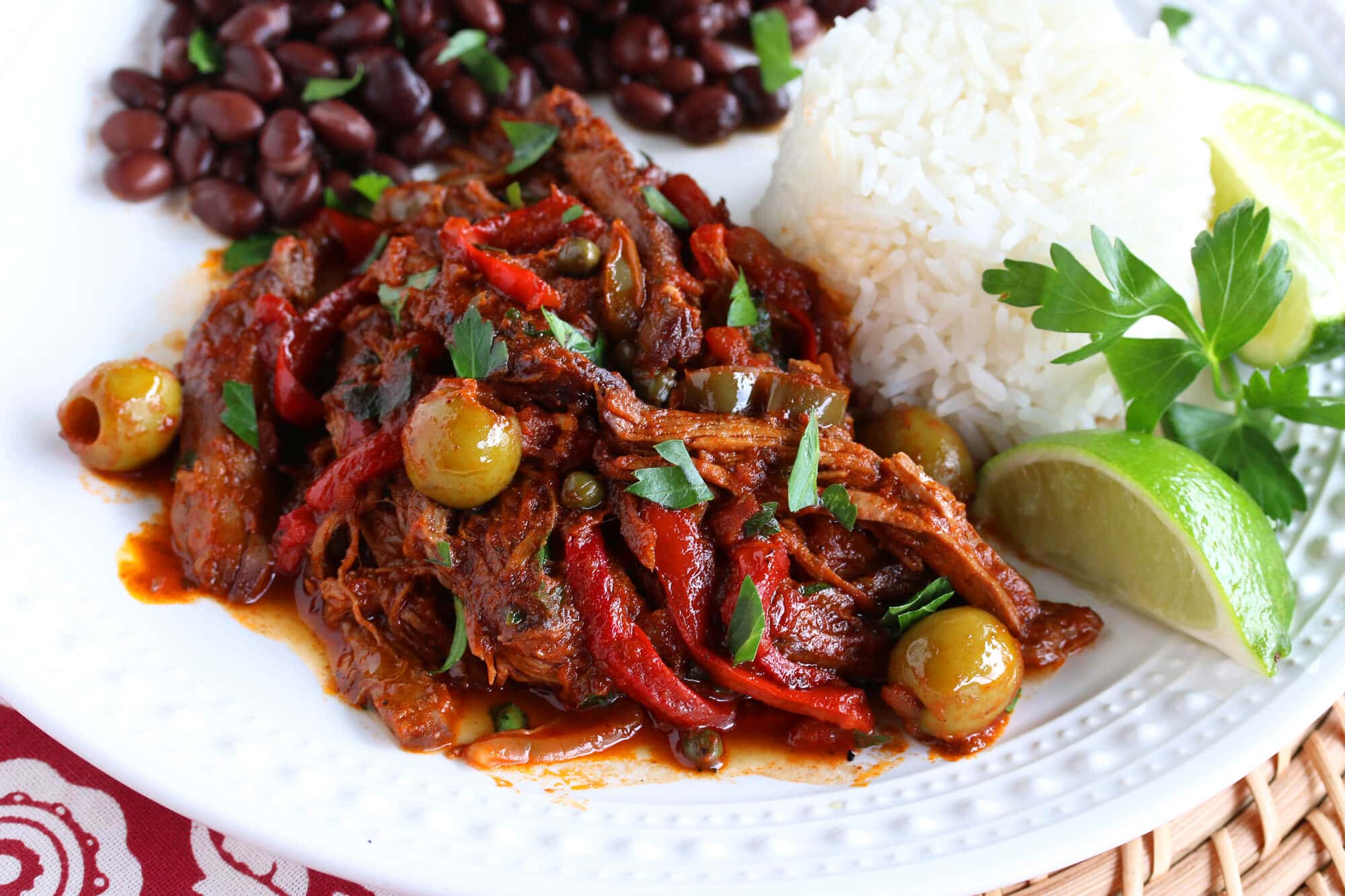
What is Ropa Vieja?
Shredded beef and vegetables that resemble a heap of colorful rags – that’s Ropa Vieja. From the Spanish term for “old clothes”, this is one of Cuba’s most popular and beloved dishes. So popular in fact that it’s one of the country’s designated national dishes.
This dish dates back to the Middle Ages of Spanish Sephardi, a loose adaptation of a dish that remains popular in southern and central Spain. Traditionally it was a way to stretch the leftovers of stews such as puchero or cocida, both of which are garbanzo-based dishes as is the original Spanish version of Ropa Vieja. This dish was later taken to Cuba where the Cubans made it their own.
Central in this dish are beef and tomatoes, both naturally umami-rich ingredients. Added to that are zesty bell peppers, caramelized onions, and to that we’re going to add some additional ingredients and spices that will make your taste buds sing with joy!
How to Make Ropa Vieja
Today we’re going to make some ultimate Ropa Vieja with a wonderfully rich depth of flavor! In the end you’ll have to make your own judgment call, but I’m pretty confident you’re going to love it (just check out the hundreds of rave reviews below)!
The traditional method for making ropa vieja involves simmering the beef in water, shredding it, and then adding it to the sauce. I’m going to show you a shortcut that not only saves time but results in a more flavorful dish. We’re going to sear the beef and then simmer it directly in the sauce, then shred it. This way all those flavorful juices from the beef go directly into the sauce. And it saves time. It’s a win-win. To mimic the extra step of making a separate stock, we’re also going to add whole carrots, celery and bay leaves and then discard them at the end, infusing the sauce with some umami qualities and natural sweetness from the vegetables.
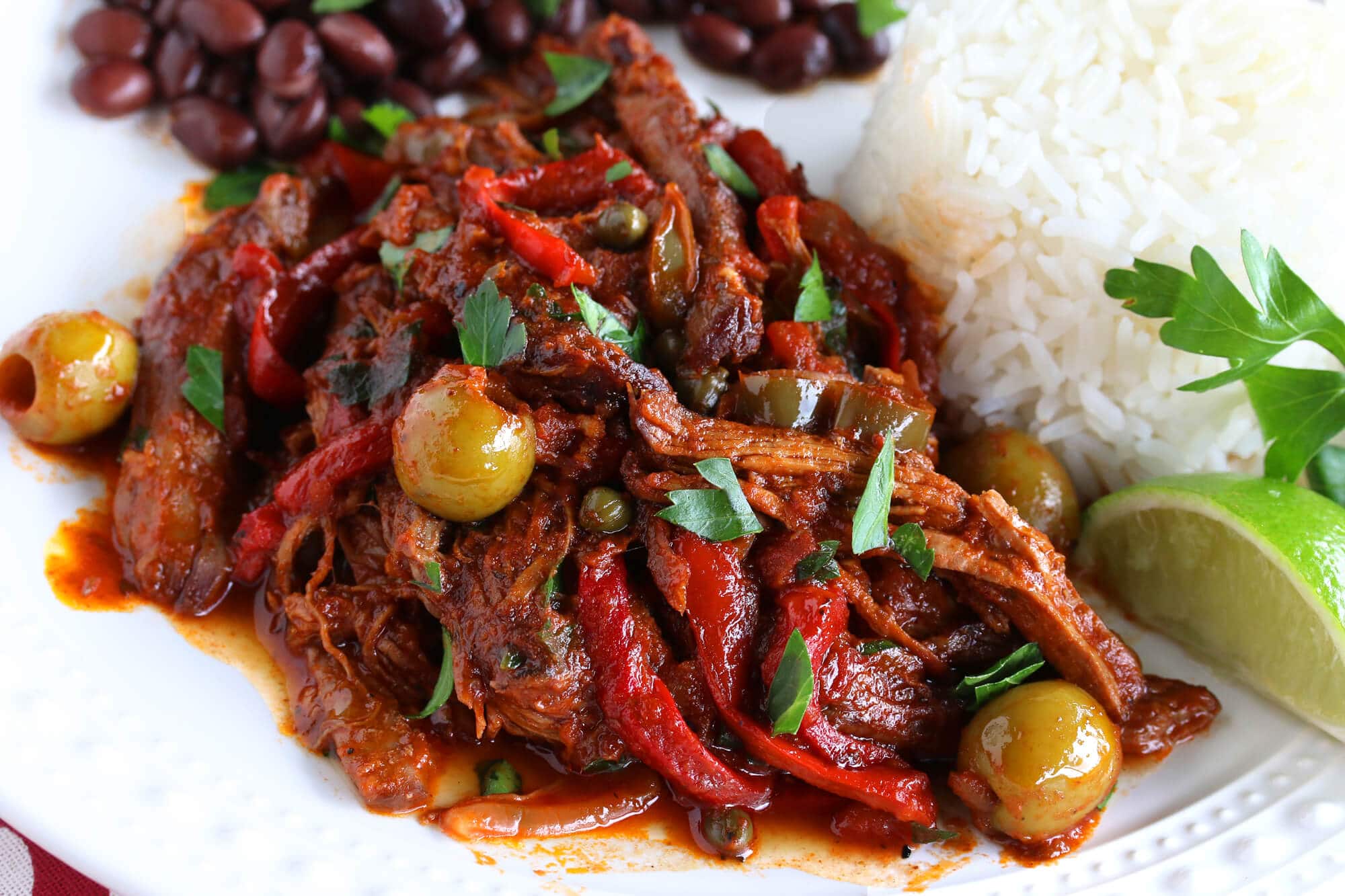
Ropa Vieja Ingredients
For our ultimate ropa vieja recipe we’re adding an array of other classic Cuban and Spanish ingredients such as olives, pimientos and capers. In addition to the red bell pepper that’s caramelized with the onions, we’re also going to add roasted red bell pepper in the end for added smokiness, sweetness and flavor.
You may be wondering, “what’s the difference between pimientos and red bell peppers? Aren’t they the same thing?” A pimiento, also called pimento or cherry pepper, is a variety of red chili pepper that is sweeter and more aromatic than red bell peppers (though some varieties of pimientos are hot). They add a nice element of natural sweetness and flavor to this dish.
What is the Best Cut of Beef to Use?
Traditionally Ropa Vieja is made with flank steak. Have a look around the internet at all the ropa vieja recipes and virtually all of them call for flank. That piqued my curiosity because here’s the thing: Flank steak is from the bottom hard-working muscle area of the cow (ie, very lean/very little fat) so it not only has less flavor than some other cuts of beef, it’s also notoriously tough.

Because of its low fat content, flank steak is best suited to very quick, high heat cooking, like grilling. It’s not the best choice for braising or slow cooking because without the fat content and connective tissue it dries out during the cooking process. For all of these reasons flank steak used to be one of the cheaper cuts of beef. But in recent years the price has sky-rocketed and in many places is double the cost of chuck. But flank still continues to be used in nearly all ropa vieja recipes out of tradition because of its shape – the grains of the cut yield long strands of shredded beef resembling the dish’s namesake, torn clothing.
Flank steak is unique in that respect with those long tough strands. But I wasn’t willing to sacrifice tenderness, flavor or cost for the sake of having long shreds of beef. So I went to three different butcher shops and chatted with their butchers. First I wanted to see their reaction when I told them I was looking for flank steak for a low and slow-cooked dish. All three raised their eyebrows and asked me why on earth I’d want flank steak for that. They all shook their heads and said that, hands down, the best choice for slow-cooked shredded beef was chuck. Better texture, better flavor and at nearly half the price of flank.
Chuck works so well for slow cooking because the long cooking time over low heat breaks down the cartilage, melts the fat and keeps the beef moist while also adding a ton of extra flavor. It’s by far the most popular beef cut of choice for slow cooking and shredding. So what about the aesthetics element, those long strands of beef you get from the flank steak? Chuck has short strands that after slow cooking and shredding typically look less pronounced and are mushier. The way around that: Simply ask the butcher to cut you a piece of chuck that is taller than it is wider (the height running with the direction of the grains). That way you’ll get longer strands along with a deliciously flavorful, tender and moist shredded beef.

Can I Make it in a Slow Cooker?
Yes! You’ll still want to sear/brown the roast first because this is essential for the best flavor. Likewise follow the instructions to saute the veggies. Then transfer the ingredients over to the slow cooker and cook on LOW for 6-8 hours or on HIGH for 4-6 hours or until the beef is tender. Remove the veggies and bay leaf and follow the instructions in Step 3 to add the final ingredients.
Can You Freeze It?
Yes! Ropa vieja freezes well. Freeze it in a freezer-safe container or freezer bag for up to 3 months. Remove it from the freezer, let it thaw in the fridge overnight, and slowly reheat it on the stovetop, in the oven, the microwave, or slow cooker.
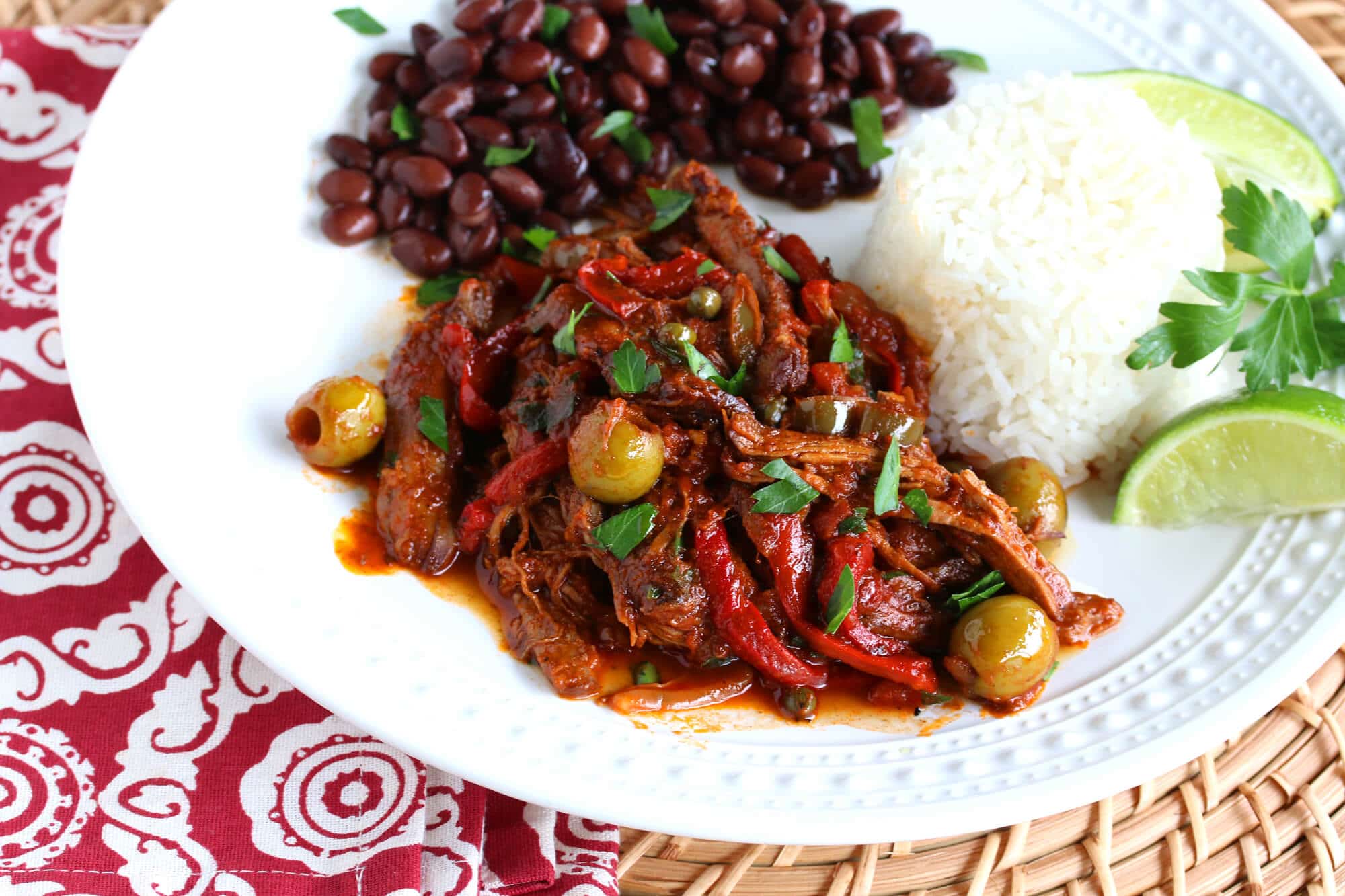
Ropa Vieja Recipe
Let’s get started!
Pat the beef dry and sprinkle with salt and freshly ground black pepper. Heat the oil in a Dutch oven over high heat. Once very hot add the beef and brown generously on all sides. I’m using my Le Creuset Dutch oven. I also have the Lodge Dutch oven that is a fraction of the price and I love them both.
Transfer the beef to a plate. Do not discard the drippings and blackened bits in the pot, they are key to the flavor.
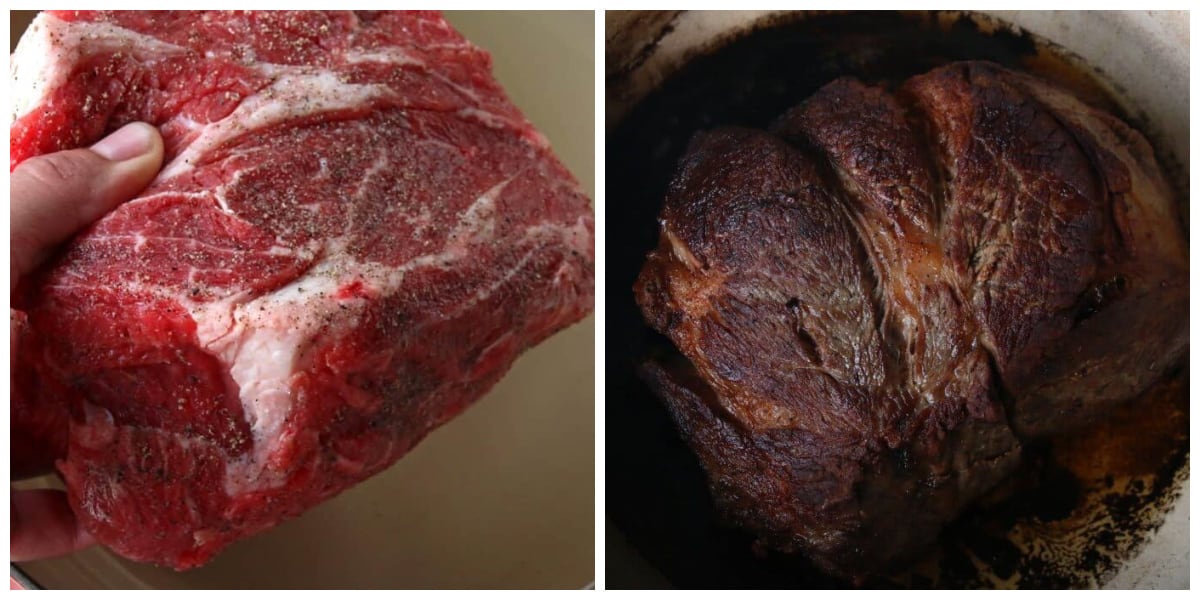
Add the sliced vegetables to the pot and cook over medium heat for 15-20 minutes until caramelized.
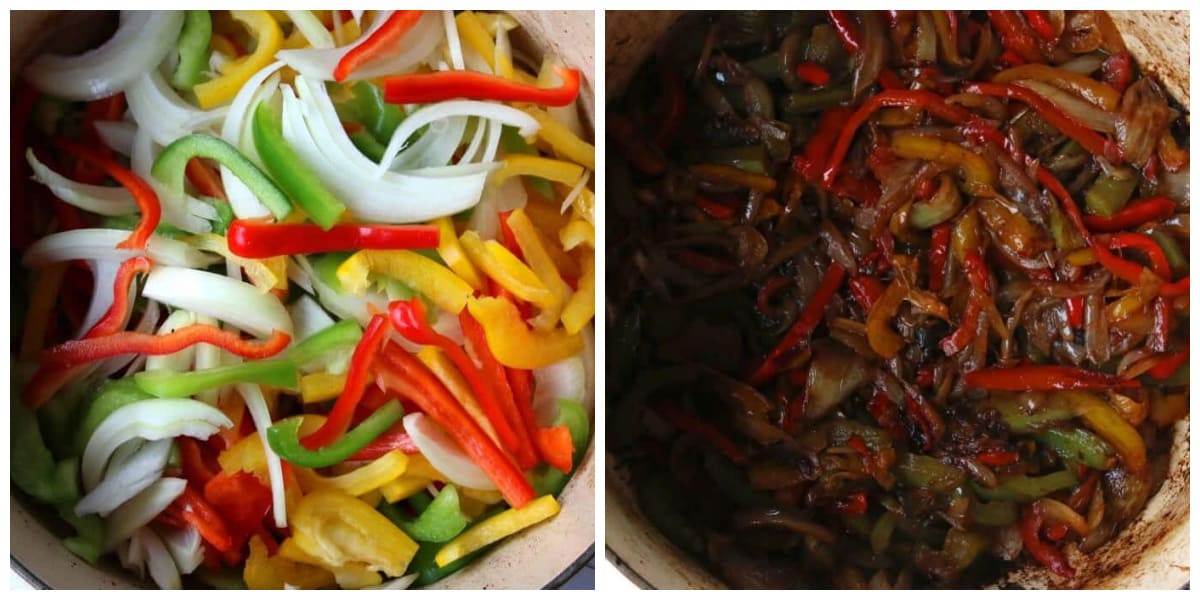
Add the garlic and spices and cook for another minute.
Add the white wine and bring it to a rapid boil, deglazing the bottom of the pan (scraping up the browned bits on the bottom of the pan).
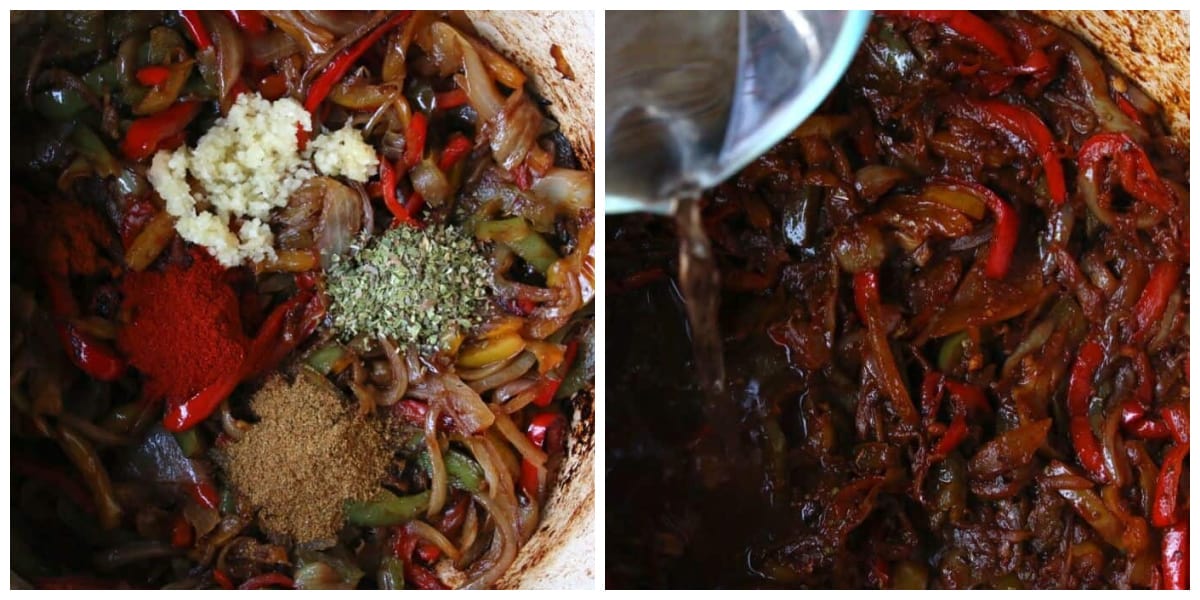
Add the broth, crushed tomatoes, tomato paste and bay leaves. Simmer for 5 minutes.
Return the roast to the pot along with the pieces of carrots and celery. Bring to a boil, reduce the heat to low, cover and simmer for 3-4 hours or until the beef is fork tender and falls apart easily.
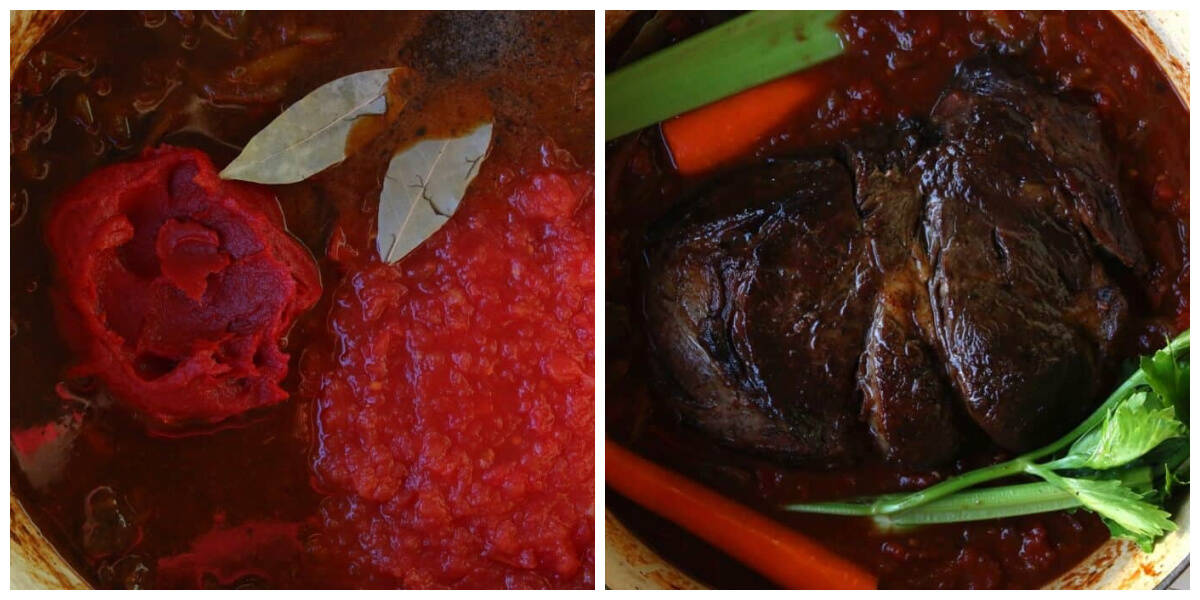
Discard the celery, carrots and bay leaves.
Transfer the beef to a plate and shred it with two forks.
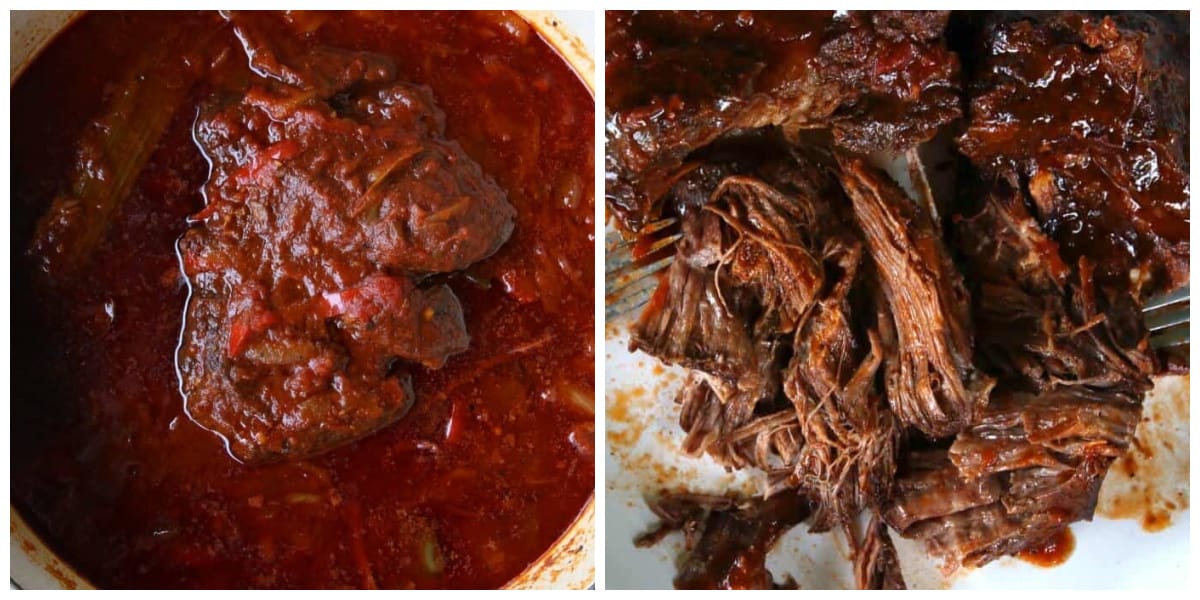
Return the shredded beef to the sauce. Stir in the olives, roasted red peppers, capers and pimientos. Simmer uncovered to thicken the sauce for 30 minutes.
Stir in the parsley. Add salt and pepper to taste.
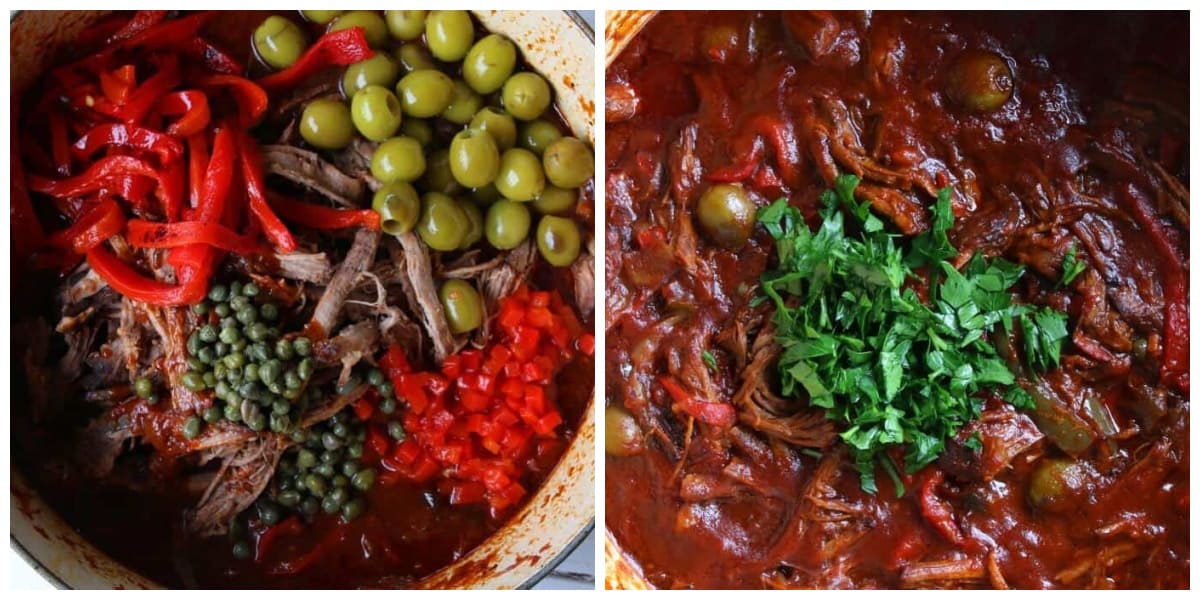
Your Ropa Vieja is ready to serve.
And its flavor only improves the next day if you can be patient enough to wait!
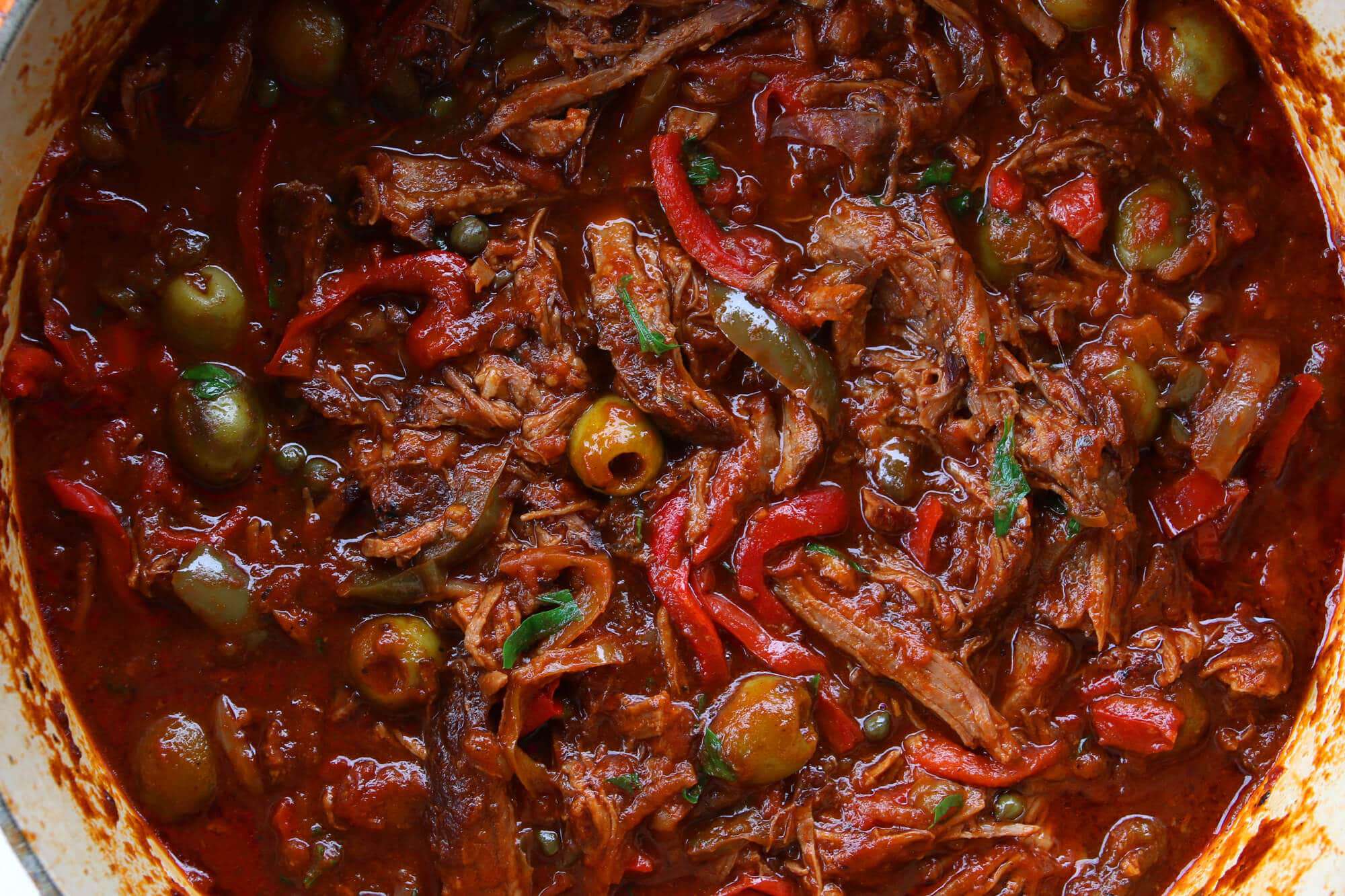
Serve with steamed or yellow rice and black beans. And for an additional treat, include some crispy homemade Tostones!
Ropa Vieja only tastes better the next day as the flavors have more time to meld, so this is a perfect dish to make in large batches for leftovers!
Enjoy!
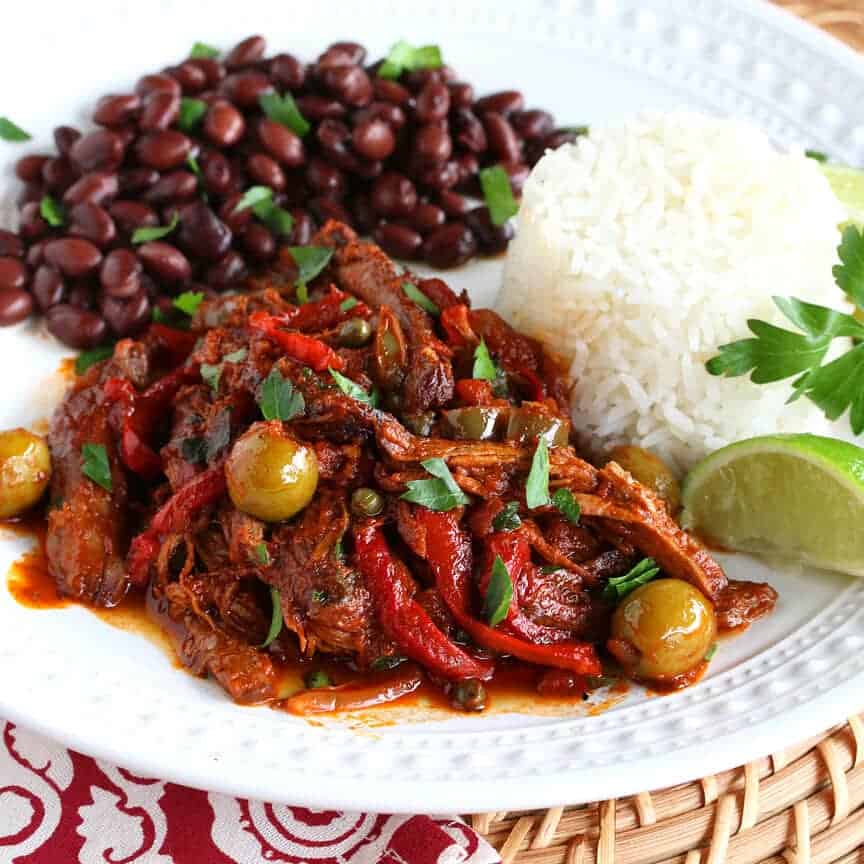
For more incredible beef stews from around the world be sure to try my:
- Guinness Stew
- Hungarian Goulash
- Sega Wat (Spicy Ethiopian Beef Stew)
- Pörkölt (Hungarian Beef and Onion Stew)
- German Goulash
- BEST Beef Stew
- Pichelsteiner
- Beef Bourguignon
- Hachee (Dutch Beef and Onion Stew)
- Domoda (Gambian Peanut Stew)
Save This Recipe
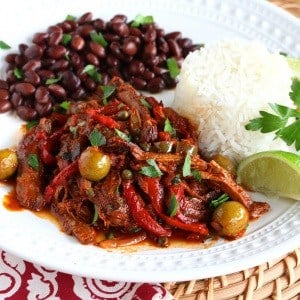
Ultimate Ropa Vieja
Ingredients
- 2 pounds chuck ask your butcher to cut it taller than wider so you get long strands of beef along the grain. OR you can use flank steak (see discussion in this post about cuts of beef and why we recommend chuck over flank)
- 1 large yellow onion thinly sliced
- 1 of each large green red and yellow bell pepper, thinly sliced
- 4 cloves garlic minced
- 2 teaspoons dried oregano
- 2 teaspoons ground cumin
- 2 teaspoons sweet paprika
- 1 teaspoon smoked paprika
- 1/8 teaspoon ground allspice
- 1/8 teaspoon ground cloves
- 2 teaspoons kosher salt
- 1/2 teaspoon freshly ground black pepper
- 1/2 cup dry white wine
- 1 cup chicken broth
- 16 ounce can crushed tomatoes
- 6 ounce can tomato paste
- 2 bay leaves
- 1 large carrot cut in half
- 1 large stalk celery cut in half
- 1 cup green olives , rinsed and drained (you can slice them if you prefer)
- 1/2 cup roasted red peppers , drained
- 1/4 cup pimientos , drained
- 2 tablespoons capers , rinsed and drained
- 1/3 cup chopped fresh parsley
Instructions
- Pat the beef dry and sprinkle with salt and freshly ground black pepper.Heat a little oil in a Dutch oven over high heat. Once very hot add the beef and brown generously on all sides. Transfer the beef to a plate. (Do not discard the drippings and blackened bits in the pot, they are key to the flavor.)Add the sliced vegetables to the pot and cook over medium heat for 15-20 minutes until caramelized. Add the garlic and spices and cook for another minute. Add the white wine and bring it to a rapid boil, deglazing the bottom of the pan (scraping up the browned bits on the bottom of the pan).Add the broth, crushed tomatoes, tomato paste and bay leaves. Simmer for 5 minutes.
- Return the roast to the pot along with the pieces of carrots and celery. Bring to a boil, reduce the heat to low, cover and simmer for 3-4 hours or until the beef is fork tender and falls apart easily. Discard the celery, carrots and bay leaves.
- Transfer the beef to a plate and shred it. Return the shredded beef to the pot.Stir in the olives, roasted red peppers, capers and pimientos. Simmer uncovered to thicken the sauce for 30 minutes. Stir in the parsley and add salt and pepper to taste.
Notes
Nutrition
Originally published on The Daring Gourmet June 27, 2016



















You’ve made me a rock star, I don’t think I’ve ever gotten such praise from the family. All plates were licked clean and my wife and kids have already requested it again. Terrific recipe.
Thanks so much, Daryl, I’m so glad it was a family hit!
Five stars! This is an excellent Ropa Vieja recipe using chuck roast as a substitute for flank steak. While the texture is not quite as dry and ‘chewy’ as the traditional method using flank steak, the flavor profile is off-the-charts with chuck roast. Considering the comparatively high cost of flank steak these days, chuck is a no-brainer. Paired with black beans and rice, the dish is perfect. This recipe is a “keeper” in my kitchen!
I’m so glad you enjoyed it, Debi, thank you very much!
This ropa vieja is unparalleled in flavor. I didn’t have capers or pimentos but I had and used everything else. I made it a day in advance and waited until the next day to eat it because of the comment about it improving in flavor over time. I can only say that it was fabulous. Next time (and yes there will guaranteed be a next time) I will get the capers and pimentos. Thank you for sharing this excellent version of one of my favorite dishes.
Thank you so much, Cliff, I’m thrilled that you enjoyed it and appreciate the feedback!
OMG there are no words for how delicious this ropa vieja is! I’ve been making this for years and this blows everything else out of the water!
Thank you so much, Tamika! :)
All I can say is WOW! I agree with all of the positive reviews on here, this recipe is exceptional. If you’re looking to up your ropa vieja game look no further.
Thank you so much, James, I’m thrilled that you enjoyed it!
This was so mouthwateringly delicious that for the first time in a while my teenagers were actually QUIET around the dinner table, lol! They were so focused on the meal that we actually got to enjoy a nice, quiet dinner. So thank you on both counts!
Lol! Well that’s just awesome, Maureen, and I’m beyond thrilled that everyone loved it, thank you! <3
Absolutely, positively, and unequivocally the best ropa vieja I’ve ever had! I normally tweak recipes when I make them, changing things here and there, but I was curious about this one and all the positive reviews so I made it as written down to the last olive and caper. I left my house to run a errand while it was cooking and the moment I stepped back in the door I already knew that I had a winner in there. My wife and our three teenagers all said how much they enjoyed it. Thank you for this recipe, Kimberly, you’ve won me over and I will be trying more of your recipes as well as making this one again. Regards, Tim Haggarty
Thank you so much, Tim, I am so happy it was a family hit!
I’m making this tonight (this will be the 2nd time I’ve made it). I follow the directions to a tee (with Chuck roast) and it tastes great. One tip: after the ropa is done cooking after the first 3-4 hours, let the meat rest in the pot for about an hour before pulling it out and shredding it. This little trick helps keep the meat a bit moister than if you pull it out immediately to shred.
Thanks so much for the feedback and the tip, Rich, I’m thrilled that you’re making it a second time!
Can you cook this in a crockpot?
Hi Mara, yes you can but definitely sear/brown the roast first and then transfer it to the slow cooker. Cook on LOW for 6-8 hours.
I made this for a monthly games night that we host for a group of about 12 people. I doubled the recipe and made it the morning of and reheated it that evening. The games took the back seat this time, it was the FOOD that everyone was talking about!
Lol, that’s fantastic, Tim, I’m thrilled it was such a hit, thank you!
I have had this dish many times and this is by far the best I’ve ever eaten. No comparison. The flavor is fantastic and is even better the next day. I’ve already had requests to make it again.
That’s fantastic, Dan, thank you so much!
Ropa vieja is a favorite of mine too. But I doubt the Sephardic connection, because the Jews were famously expelled from Spain in 1492, and tomatoes did not arrive in Spain until well into the next century.
Hi David, the earliest versions wouldn’t have included tomatoes, just as the earliest versions of Hungarian goulash wouldn’t have included paprika. Many of these age-old dishes changed and adapted over time as new ingredients were introduced and became more widely available.
This turned out great for the most part- the flavors are nice and rich as I expected. I did cut the recipe in half and I used chuck roast (I could not find any cuts that were taller, unfortunately). The lean parts of the meat ended up being a little tougher than expected and not easy to shred. I am wondering if I browned it to much in the beginning? Or perhaps, although half the size, it needed more time to cook? I plan to make this again for a special occasion and hope I can do it better the next time. Any advice would be appreciated, thanks!
Hi Mary, I’m glad you enjoyed it, thank you! Browning wasn’t the problem but yes, it needed to cook longer. Even though the roast was half the size it will still require that long and slow cooking time.
Awesome meal, and easy prep/cook. Made this for a Christmas party for the family, and 12 people scarfed this up and left me with nothing to take home for leftovers!
So delicious as written in the recipe…followed without changes. This recipe takes a tough cut of chuck roast and makes it a tender, flavorful, and belly-filling meal for the whole family.
Thanks so much for a delicious dish!
Respect!
Amateur Chef Jeff in Houston
I’m beyond thrilled to hear that Chef Jeff, thank you so much for the feedback! <3
This was delicious! I actually used stew meat, cause of time, and it shredded fine! My family loved it! Definitely is better the second day!
I’m so glad, Donna, thank you! And I agree 100% about the second day!